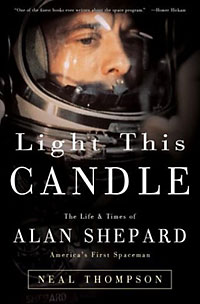Review: Light This Candleby Jeff Foust
|
| On several occasions in his life Shepard flirted with failure, in particular during his time at the academy and in flight school after the war. |
Thompson addresses this with a detailed account of Shepard’s life, from his childhood in New Hampshire to his final years battling leukemia in California. Because both Shepard and his wife passed away within a few weeks of each other in 1998, years before Thompson started the book, he instead relies on a wide range of interviews with family members, astronaut and Navy colleagues, and others who knew Shepard. He also had access to a number of documents, including an over 400-page dossier on Shepard compiled by the FBI.
Among other things, the book reveals an interesting aspect about Shepard’s life. Shepard was widely acknowledged as an excellent pilot and an intense competitor, as the book notes a number of times, particularly when Shepard and John Glenn jockeyed for the first Mercury flight. Yet, on several occasions Shepard flirted with failure, in particular during his time at the academy and later, after the war, in flight school in Texas. (Some of those problems were self-inflicted, such as when his love of flat-hatting—high-speed, low-altitude flying—nearly led to his court martial while a test pilot at Pax River in the early 1950s.) Yet, each time Shepard showed the ability to turn his fortunes around with a lot of hard work and a little bit of luck, attributes that would serve him well as an astronaut.
Light This Candle is not perfect, but any errors are fairly minor: Thompson writes at one point that the Earth;’s gravitational pull “dissipates” a few hundred miles above the surface, causing weightlessness; late in the book he states that NASA announced it was flying Glenn on the shuttle in 1996, when in fact that announcement was made in early 1998. Overall, Thompson’s book offers the best insight yet into the man dubbed the “Icy Commander”, a man who, despite the nickname, was passionate about serving his country and flying higher and faster than anyone else.
